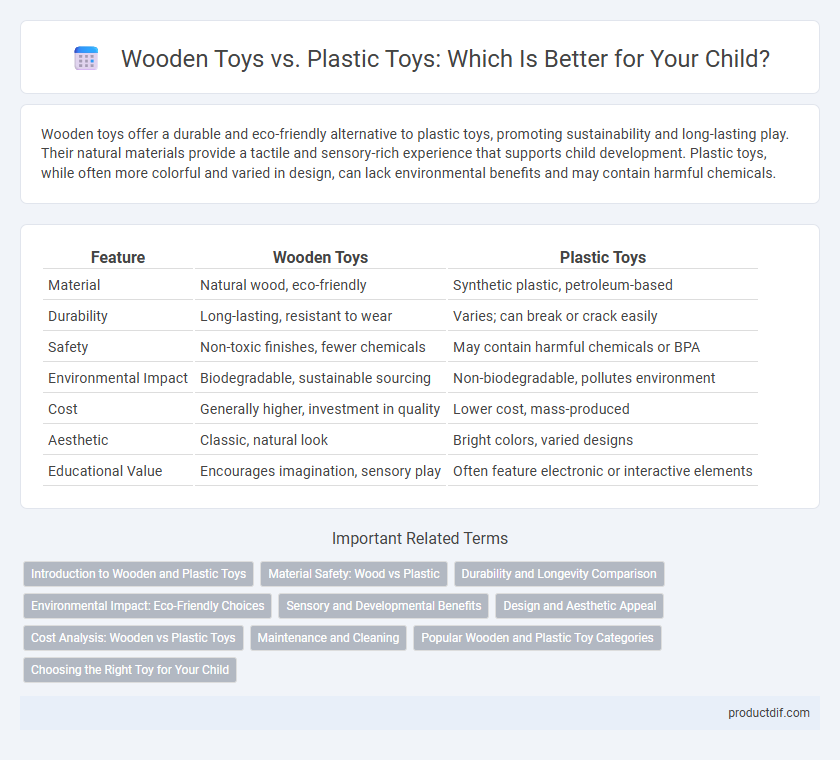Wooden toys offer a durable and eco-friendly alternative to plastic toys, promoting sustainability and long-lasting play. Their natural materials provide a tactile and sensory-rich experience that supports child development. Plastic toys, while often more colorful and varied in design, can lack environmental benefits and may contain harmful chemicals.
Table of Comparison
| Feature | Wooden Toys | Plastic Toys |
|---|---|---|
| Material | Natural wood, eco-friendly | Synthetic plastic, petroleum-based |
| Durability | Long-lasting, resistant to wear | Varies; can break or crack easily |
| Safety | Non-toxic finishes, fewer chemicals | May contain harmful chemicals or BPA |
| Environmental Impact | Biodegradable, sustainable sourcing | Non-biodegradable, pollutes environment |
| Cost | Generally higher, investment in quality | Lower cost, mass-produced |
| Aesthetic | Classic, natural look | Bright colors, varied designs |
| Educational Value | Encourages imagination, sensory play | Often feature electronic or interactive elements |
Introduction to Wooden and Plastic Toys
Wooden toys are crafted from natural, renewable materials offering durability and a classic aesthetic that appeals to eco-conscious consumers. Plastic toys provide versatility in design, vibrant colors, and affordability, making them widely accessible and popular among children. Both types of toys serve different developmental purposes, with wooden toys encouraging imaginative play and plastic toys often incorporating electronic features for interactive experiences.
Material Safety: Wood vs Plastic
Wooden toys are often preferred for their natural, non-toxic materials, using untreated or water-based finishes that reduce exposure to harmful chemicals. Plastic toys may contain phthalates, BPA, and other hazardous substances that pose risks to children's health, especially if they are poorly regulated or made from low-quality plastics. Choosing wooden toys made from sustainably sourced hardwood ensures greater material safety and environmental benefits compared to conventional plastic alternatives.
Durability and Longevity Comparison
Wooden toys exhibit superior durability and longevity compared to plastic toys due to their solid construction and natural materials, which resist wear and tear over time. Unlike plastic toys that can easily crack, fade, or break, wooden toys often withstand heavy use and environmental factors without significant damage. This durability makes wooden toys an eco-friendly investment for long-term play and collector value.
Environmental Impact: Eco-Friendly Choices
Wooden toys have a significantly lower environmental impact than plastic toys due to their biodegradability and sustainable sourcing from renewable forests. Plastic toys, often derived from non-renewable petroleum, contribute to long-term pollution and landfill waste, taking hundreds of years to decompose. Choosing eco-friendly wooden toys supports reduced carbon footprints and promotes sustainable manufacturing practices that protect ecosystems.
Sensory and Developmental Benefits
Wooden toys offer rich tactile experiences and natural textures that enhance sensory development and fine motor skills in children. Unlike plastic toys, which often provide uniform surfaces and limited sensory engagement, wooden toys encourage imaginative play and cognitive growth through varied shapes and weights. Studies show that children exposed to natural materials like wood exhibit improved sensory integration and problem-solving abilities.
Design and Aesthetic Appeal
Wooden toys boast a timeless design characterized by natural textures and warm tones that enhance sensory development and aesthetic appreciation in children. Plastic toys offer vibrant colors and intricate shapes achieved through advanced molding techniques, providing diverse visual stimulation and modern appeal. The choice between wooden and plastic toys often hinges on preferences for eco-friendly, minimalist design versus bold, detailed aesthetics.
Cost Analysis: Wooden vs Plastic Toys
Wooden toys generally have a higher upfront cost due to quality materials and craftsmanship, but they offer greater durability and longevity, reducing replacement expenses over time. Plastic toys often come at a lower initial price, making them more accessible, yet they tend to wear out or break quicker, potentially increasing long-term costs. When evaluating cost-effectiveness, consider not only purchase price but also durability, lifespan, and environmental impact.
Maintenance and Cleaning
Wooden toys require gentle cleaning with mild soap and water to prevent damage and maintain their natural finish, making them more durable with proper care. Plastic toys can be easily wiped down with disinfectant wipes or soaked in soapy water, offering simpler maintenance but potentially degrading faster over time. Both types benefit from regular cleaning to ensure safety and longevity.
Popular Wooden and Plastic Toy Categories
Wooden toys such as building blocks, puzzles, and classic train sets remain popular for their durability, eco-friendliness, and educational value, encouraging imaginative play and fine motor skills. Plastic toys dominate in categories like action figures, dolls, and electronic gadgets due to their versatility, vibrant colors, and ability to incorporate interactive features. Both wooden and plastic toys cater to diverse developmental needs, with wooden toys often preferred for early childhood learning and plastic toys favored for their wide range of themes and technological integration.
Choosing the Right Toy for Your Child
Wooden toys offer durability, natural materials, and eco-friendliness, making them ideal for children who benefit from tactile learning and imaginative play. Plastic toys provide vibrant colors, diverse designs, and interactive features that stimulate sensory development and motor skills. Selecting the right toy depends on your child's age, interests, and developmental needs, balancing safety, educational value, and environmental impact.
Wooden Toys vs Plastic Toys Infographic

 productdif.com
productdif.com